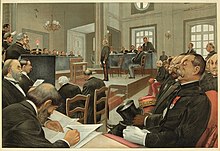
Back Vanity Fair (britisk magasin) Danish Vanity Fair (englisches Magazin) German Vanity Fair (revista británica) Spanish Vanity Fair (journal) French ואניטי פייר (כתב עת, 1868) HE Vanity Fair Hungarian Vanity Fair (rivista britannica) Italian バニティ・フェア (イギリスの雑誌) Japanese Vanity Fair (британский журнал) Russian Vanity Fair (британський журнал) Ukrainian

Vanity Fair was a British weekly magazine that was published from 1868 to 1914. Founded by Thomas Gibson Bowles in London, the magazine included articles on fashion, theatre, current events as well as word games and serial fiction. The cream of the period's "society magazines", it is best known for its witty prose and caricatures of famous people of Victorian and Edwardian society, including artists, athletes, royalty, statesmen, scientists, authors, actors, business people and scholars.[1][2]
Taking its title from Thackeray's popular satire on early 19th-century British society, Vanity Fair was not immediately successful and struggled with competition from rival publications. Bowles then promised his readers "Some Pictorial Wares of an entirely novel character", and on 30 January 1869, a full-page caricature of Benjamin Disraeli appeared. This was the first of over 2,300 caricatures to be published. According to the National Portrait Gallery in London, "Vanity Fair's illustrations, instantly recognizable in terms of style and size, led to a rapid increase in demand for the magazine. It gradually became a mark of honour to be the 'victim' of one of its numerous caricaturists. Bowles's witty accompanying texts, full of insights and innuendoes, certainly contributed towards the popularity of these images".[2]
- ^ "Vanity Fair: The One-Click History". Vanity Fair. Retrieved 18 March 2022.
- ^ a b Cite error: The named reference
NPGwas invoked but never defined (see the help page).
© MMXXIII Rich X Search. We shall prevail. All rights reserved. Rich X Search